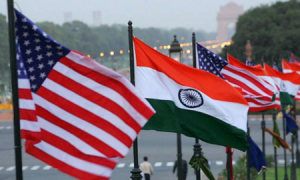India, US talks going on for trade pact; no compromise on agri, dairy, GM products: Sources

New Delhi: The negotiations between India and the US are still going on for an interim trade deal, though there will be no compromise on the red lines with regard to duty concessions on agriculture items, dairy, and genetically modified (GM) products, sources said Friday.
The two countries are negotiating a bilateral trade agreement (BTA). They are aiming to conclude the first phase of the pact by fall (October-November) this year.
The two nations are also looking at an interim trade deal before the first tranche.
“Engagement between the two are continuously going on for the pact,” they said, adding that, however, India has clearly drawn a red line for agriculture items, dairy, and genetically modified (GM) products.
Because of the use of animal feed in the American dairy sector, it would not be possible for India to provide duty concessions on such goods.
India has never given any duty concessions in any of its earlier trade pacts in this sector.
“There are religious sentiments in the dairy sector. So, it is not acceptable. There will be no compromise on these segments in any of India’s trade pacts,” they said.
Commerce and Industry Minister Piyush Goyal Thursday in Parliament stated that India will take all necessary steps to safeguard and promote national interest.
He has said the government is examining the implications of these tariffs and has engaged with all stakeholders, including exporters and industry, to gather feedback on their assessment of the situation.
India and the US have been negotiating a bilateral trade agreement since March. So far, five rounds of talks have been completed.
The sixth round of talks will be held from August 25.
India’s chief negotiator and special secretary in the Department of Commerce Rajesh Agrawal, and Assistant US Trade Representative for South and Central Asia Brendan Lynch held the deliberations.
US President Donald Trump unveiled sweeping new tariffs on dozens of countries, including 25 per cent duties for goods from India, marking a new era of American protectionism that triggered fresh tensions and concerns over a much wider disruption in the global trade landscape. It will come into force from August 7.
With America, India had a trade surplus (the difference between imports and exports) of USD 41 billion in 2024-25. It was USD 35.32 billion in 2023-24 and USD 27.7 billion in 2022-23.
In 2024, India’s main exports to the US included drug formulations and biologicals (USD 8.1 billion), telecom instruments (USD 6.5 billion), precious and semi-precious stones (USD 5.3 billion), petroleum products (USD 4.1 billion), vehicle and auto components (USD 2.8 billion), gold and other precious metal jewellery (USD 3.2 billion), ready-made garments of cotton, including accessories (USD 2.8 billion), and products of iron and steel (USD 2.7 billion).
Imports included crude oil (USD 4.5 billion), petroleum products (USD 3.6 billion), coal, coke (USD 3.4 billion), cut and polished diamonds (USD 2.6 billion), electric machinery (USD 1.4 billion), aircraft, spacecraft and parts (USD 1.3 billion), and gold (USD 1.3 billion).
India is seeking the removal of this additional tariff. It is also looking at the easing of tariffs on steel and aluminium (50 per cent) and the auto sector (25 per cent). These issues are an important part of the trade pact negotiations.
Against these, India has reserved its right under the WTO (World Trade Organization) norms to impose retaliatory duties.
The country is also seeking duty concessions for labour-intensive sectors, such as textiles, gems and jewellery, leather goods, garments, plastics, chemicals, shrimp, oil seeds, grapes, and bananas, in the proposed trade pact.
On the other hand, the US wants duty concessions on certain industrial goods, automobiles, especially electric vehicles, wines, petrochemical products, agri goods, dairy items, apples, tree nuts, and genetically modified crops.
India’s merchandise exports to the US rose 22.8 per cent to USD 25.51 billion in the April-June quarter of this financial year, while imports rose 11.68 per cent to USD 12.86 billion.
PTI
News